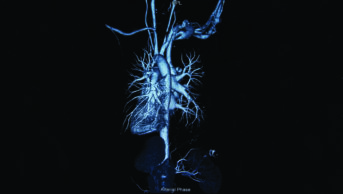Pharmacological management of acute decompensated heart failure with reduced ejection fraction (HFrEF) reduces mortality and morbidity[1]. International and local guidelines recommend with class I evidence for the use of renin-angiotensin system inhibitor (RAASi), beta-blocker, mineralocorticoid receptor antagonist (MRA) and sodium-glucose co-transporter 2 inhibitor (SGLT2i)[1–4]. Therefore, these medicines should be started in hospital at the earliest opportunity unless contraindicated. A retrospective audit was initiated at Middlemore Hospital, New Zealand, to determine the proportion of patients being appropriately prescribed guideline-directed medical therapy (GDMT) at discharge following hospitalisation with acute decompensated HFrEF.
For the purpose of the audit, patients on GDMT were defined as those who were prescribed RAASi, beta-blocker and MRA. If the patient is not on GDMT at time of discharge, they should still be discharged on rationalised medical therapy provided that the reason for non-GDMT is stated clearly in the electronic discharge summary, or if there is clear documented allergy/adverse drug reaction to any medicine concerned. Patients not on GDMT owing to medical contraindications are termed to be on “rationalised medical therapy”. The prescribing of SGLT2i is reported as a secondary outcome because the use of this class of medicine is currently limited by funding restrictions in New Zealand.
The standard was set at 80% to account for suboptimal and inconsistent documentation. A total of 339 hospital discharges were identified during the audit period between 30 September 2021 and 30 March 2022 via a data analyst, a random sample of 62 patients were selected and audited following statistician’s recommendations.
Despite strong evidence for GDMT for heart failure (HF) management, the audit identified prescribing gaps — only 71% (44/62) discharged from hospital on rationalised medical therapy, taking into account contraindications to these medicines. This failed to meet our audit standard of 80%. With regards to separate components of GDMT, both RAASI and beta-blocker therapy were rationalised above the set minimal standard at time of discharge to 92% and 91%, respectively. MRA therapy rationalisation was 79%, just below the minimal standard. One in three patients discharged with non-rationalised therapy were owing to multiple therapy omissions rather than single therapy omission. MRA omission is responsible for 72% of non-rationalised therapy at discharge.
With regards to SGLT2i prescribing, 10 patients were eligible for SGLT2i but only 50% were prescribed therapy on discharge, while 36 patients had no contraindication but did not meet funding criteria.
To help improve initiation of GDMT in hospital, the following recommendations were made:
- Formalised heart-failure pathways from admission summaries to discharge summaries to encourage rationalisation of HF therapy;
- HF medication education for resident doctors and pharmacists;
- Appointment of a designated HF pharmacist in general medicine who reviews medicines for all patients admitted with decompensated HF under general medicine;
- Submission to PHARMAC for extended funding criteria for SGLT2i to remove the requirement for having type 2 diabetes mellitus.
The aspiration of the team is for close to 100% of patients to be discharged on rationalised medical therapy. Further audits would be useful to compare performance following implementation of recommended changes.
Athena Sun, cardiology pharmacist, clinical pharmacy, Te Whatu Ora Counties Manukau, Auckland
Jack He, cardiology registrar, Department of Cardiology, Te Whatu Ora Waitamatā
Daniel Chan, cardiologist, Department of Cardiology, Te Whatu Ora Te Tai Tokerau
- 1McDonagh TA, Metra M, Adamo M, et al. 2021 ESC Guidelines for the diagnosis and treatment of acute and chronic heart failure. European Heart Journal. 2021;42:3599–726. https://doi.org/10.1093/eurheartj/ehab368
- 2Atherton JJ, Sindone A, De Pasquale CG, et al. National Heart Foundation of Australia and Cardiac Society of Australia and New Zealand: Guidelines for the Prevention, Detection, and Management of Heart Failure in Australia 2018. Heart, Lung and Circulation. 2018;27:1123–208. https://doi.org/10.1016/j.hlc.2018.06.1042
- 3Heidenreich PA, Bozkurt B, Aguilar D, et al. 2022 ACC/AHA/HFSA Guideline for the Management of Heart Failure. Journal of Cardiac Failure. 2022;28:e1–167. https://doi.org/10.1016/j.cardfail.2022.02.010
- 4Atherton JJ, Sindone A, De Pasquale CG, et al. National Heart Foundation of Australia and Cardiac Society of Australia and New Zealand: Australian clinical guidelines for the management of heart failure 2018. Medical Journal of Australia. 2018;209:363–9. https://doi.org/10.5694/mja18.00647
You may also be interested in

Heart attack risk raised in week after respiratory infection, say researchers

Diltiazem use with anticoagulants associated with higher risk of bleeding compared with metoprolol in older people, study finds
